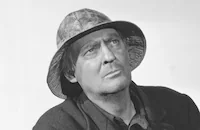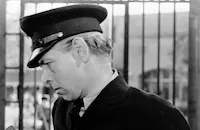The Devil-Doll

Brief Synopsis
Cast & Crew
Tod Browning
Lionel Barrymore
Maureen O'sullivan
Frank Lawton
Rafaela Ottiano
Robert Greig
Film Details
Technical Specs

Synopsis
Paul Lavond, wrongly convicted of robbing his own Parisian bank and killing a night watchman more than seventeen years previously, escapes from Devil's Island with Marcel, an old scientist who is near death. Marcel yearns for his wife Malita and a continuation of his work, while Paul lives for vengeance that he has promised against the three partners who framed him for their crime. On the night that Paul and Marcel reach Malita's home, Marcel and Malita secretly conduct an experiment on Lachna, a young serving girl who works for Malita. Previously, Malita had been able to shrink living animals into a miniature size. After performing the experiment on Lachna, the girl is reduced to the size of a little doll, whose actions are stimulated by hypnotic thought processes. Marcel dies soon after the experiment, but Malita wants to continue with her work. Paul sees the doll-like creature as a way to exact his revenge and, though Malita is more interested in science, she agrees to go with him to Paris. Paul disguises himself as Mme. Mandelip, an old woman who owns a toy shop and, through the use of drugs, captures others who are then reduced in size by Malita. When he secretly visits his mother, she tells him that, after his wife's death, his daughter Lorraine grew up in poverty and hatred of her father, whom she believed to be guilty, and now works very hard as a laundress in a wash house.
More resolved than ever to enact his plan against his former partners, Paul goes to his first victim, Victor Radin, whom Paul visits disguised as Mme. Mandelip. Paul shows Radin one of the "animated" animal dolls and Radin is so impressed that he agrees to invest in Mme. Mandelip's invention. One night, when Radin visits the toy shop, he too, is turned into a doll. When Emil Coulvet learns that Radin is missing, he becomes terrified that Paul is finally getting his revenge and asks the police for help, but Paul's disguise enables him to elude capture. As Mme. Mandelip, Paul sells a doll to Coulvet's wife and, by means of thought transference, is able to instruct the doll to steal Mme. Coulvet's jewels and throw them into the street where Paul is waiting in his disguise. He next instructs the doll to inject Coulvet with a drug that causes him to become completely paralyzed. Meanwhile, Paul has met his daughter as Mme. Mandelip and learns that she is a lovely, though bitter young woman, who is engaged to a taxi driver named Toto. After Coulvet's paralysis, Charles Matin, the third partner, becomes so frightened that he calls the police to seek their assistance. The police then come to Matin's house to protect him. Unknown to them, Radin, now doll-size, has been been hidden as an ornament on Matin's Christmas tree. Under the control of Paul's thoughts, Radin slips down from the tree and sneaks under the furniture. He is about to stab Matin in the leg when the terrified man jumps to his feet and confesses all his crimes in the hope of saving himself from Paul's vengeance.
With his revenge now complete, Paul wants to stop the experiments, but Malita angrily insists that they continue Marcel's work. The two argue, and Malita causes an explosion that destroys the doll shop. Unable to save Malita, Paul escapes into the night. The next day, in the ruble of the shop, the police conclude that Mme. Mandelip is, indeed, the person responsible for the devil dolls. Later, Paul hires Toto's taxi and as they drive through Paris, reveals his identity. Wanting to speak privately, the men go to the top of the Eiffel Tower, where Paul explains that he must disappear forever because of the crimes he has committed. Paul explains that his only purpose was to have the Lavond family's reputation restored and make sure that the money stolen from him will go to Lorraine and his mother. Despite Toto's urging to stay, Paul starts to leave but hesitates when Lorraine, whom Toto had forgotten was to meet him there, arrives on the tower's elevator. Paul then tells Lorraine that he escaped from Devil's Island with her father, who died. After telling her of her father's unfaltering love for her, Paul says goodbye and enters the tower elevator as Toto and Lorraine lovingly embrace. On the way down, Paul smiles as he tells the elevator operator that this has been the greatest evening of his life.

Director

Tod Browning
Cast

Lionel Barrymore

Maureen O'sullivan

Frank Lawton

Rafaela Ottiano
Robert Greig
Lucy Beaumont

Henry B. Walthall

Grace Ford
Pedro De Cordoba

Arthur Hohl

Juanita Quigley
Claire Du Brey
Rollo Lloyd

E. Allyn Warren

Billy Gilbert

Eily Malyon
Christian J. Frank
Sherry Hall
Francis Mcdonald
Robert Graves

Edward Keene
Nick Thompson
Robert Du Couedic
Inez Palange
Evelyn Selbie
Paul Foltz
Jean Alden
Crew
Tod Browning
Tod Browning
Guy Endore
Paul Foltz
Garrett Fort
Cedric Gibbons
Edward J. Mannix
Val Raset
Stan Rogers
Richard Schayer
Harry Sharrock
Douglas Shearer
Fredrick Y. Smith
Leonard Smith
Erich Von Stroheim
Dolly Tree
Franz Waxman
Edwin B. Willis

Photo Collections
Videos
Movie Clip



Trailer
Film Details
Technical Specs

Articles
The Devil Doll - The Devil Doll
Few critics, if any, have ever commented on Tod Browning's visual style, which could best be described as static and resembling a photographed stage play. This is certainly true of his most famous film, Dracula (1931) but The Devil Doll is another matter entirely. It's a very smooth, visually accomplished piece of cinema that has earned it a cult following in recent years. The special effects are impressive for the era, particularly the scenes featuring oversized sets and "miniature" people. Also part of the film's cult appeal is Browning's twisted sense of humor, which is most evident in the scenes with Malita who becomes addicted to miniaturizing humans. It's actually surprising that the Hays Office didn't have major censorship issues with The Devil Doll but they did dictate a moralistic ending in which the Barrymore character atones for his crimes.
Odd as The Devil Doll may sound (it was co-scripted by Erich Von Stroheim), it fits well within the Browning canon of bizarre storylines. His other films include The Unknown (1927), where Lon Chaney deliberately fashions himself into a sideshow freak by having his arms amputated. It's an unclassifiable film that effectively conveys a sense of humanity and unity among the sideshow circus performers (dwarfs, hermaphrodites, pinheads, etc.) and it is arguably Browning's most personal and cathartic film (Browning was a teenage runaway who joined a traveling carnival).
Director: Tod Browning
Producer: Edward J. Mannix
Screenplay: Garrett Fort, Guy Endore, Erich Von Stroheim (based on the novel Burn Witch Burn by Abraham Merritt)
Cinematography: Leonard Smith
Editor: Frederick Y. Smith
Art Direction: Cedric Gibbons
Music: Franz Waxman
Cast: Lionel Barrymore (Paul Lavond), Henry B. Walthall (Marcel), Maureen O'Sullivan (Lorraine Lavond), Rafaela Ottiano (Malita), Frank Lawton (Toto), Robert Greig (Coulvet), Lucy Beaumont (Mme. Lavond).
BW-79m.
by Michael Toole

The Devil Doll - The Devil Doll
Quotes
Once you're in my shop, I'll wager you'll do anything I ask.- Lavond (as Madame Mandelip)
Trivia
Notes
The film's working title was The Witch of Timbuctoo. Some televised airings of the film end after the exlposion of the toy shop. According to Hollywood Reporter, this was the last film completed by Henry B. Walthall before his death. Walthall died while working on his next film, China Clipper. Actress Grace Ford made her motion picture debut in The Devil-Doll. The Variety reviewer pointed out the similarity of the sequences in the film in which Lionel Barrymore's character, "Paul Lavond," pretends to be the elderly top shop proprietress "Mme. Mandelip," to aspects of the 1925 film The Unholy Three (see below), also directed by Tod Browning for M-G-M. In the earlier film, Lon Chaney's character disguised himself as the elderly proprietress of a bird shop.

Miscellaneous Notes
Released in United States 1936
Released in United States 1936














